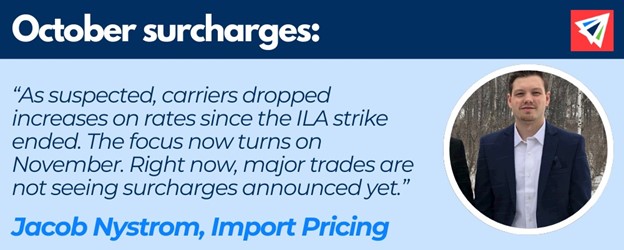Competitive Edge
October 16th, 2024
Stay Current with InterlogUSA
Latest Industry Happenings and Market Updates:
Across International Shipping: News and Developments
[Labor] Port of Montreal Overtime Strike: Unionized dockworkers at the Canadian port are indefinitely engaged in a partial strike against overtime work. This means all Port of Montreal terminals are still open, but dockworkers will not be working overtime as part of their duties. The labor action is expected to create processing delays and container congestion.
[Weather] Federal Hurricane Aid Heads to Impacted States: The Federal Highway Administration has approved $134 million in quick-release emergency funds for North Carolina, South Carolina, and Tennessee state transportation departments. The aid will address damage to roads and bridges caused by Hurricane Helene in late September.
Among the notably impacted are interstates 26 and 40 which run through these Appalachia states. The brunt of the destruction lies on stretches in western North Carolina.
Truckload freight movement in the region will be subject to indefinite detours and longer transits.
[International Business] Terminal Expansion Positions London to Be U.K.’s Largest Port: Terminal operator DP World is moving forward with a $1.3 billion expansion of the London Gateway terminal. The capacity-boosting project will complete a planned six-berth terminal while also breaking ground on a second rail terminal.
Expected to be completed by 2030, the expansion is aimed to make the London multimodal hub the largest container port in the U.K., surpassing the Port of Felixstowe. London Gateway is located on the River Thames estuary about 30 miles east of London.
IMPORT: Asia to North America (Transpacific Eastbound)
Rates: Rates have slightly decreased from the beginning of October. All ocean carriers renounced mid-October surcharges related to the now-defunct longshore strike.
Congestion: Mild congestion related to the longshore strike in early October has diminished. Cargo handling operations at USEC/GC ports are presumed normal.
Space: Post-Golden Week bookings have not strained vessel space on China-U.S. services.
TIPS:
- As the year reaches its end, Q4 can be the right time to get a head start on your 2025 transportation and logistics strategies. While business needs can vary, in most cases, a discussion and evaluation of service providers (carriers, forwarders, Customs brokers, etc.,) should be top of mind, especially as it relates to any potential shortcomings in existing providers throughout 2024.
IMPORT: Europe to North America (Transatlantic Westbound)
Rates: Aside from a traditional round of peak season surcharges (PSSs), rates have generally shown little change since August.
Capacity: Available capacity at Europe ports have shown some signs of strain.
EXPORT: North America to Asia
Harvest Season: The peak season for U.S. agriculture exports is underway. Outbound rail and barge volumes to U.S. ports surge.
Rates: Rates are healthy given seasonal demand from agriculture exports.
Space: Exporters can return to moving outbound loads via East Coast railroads or river barges to the Gulf Coast as the strike has ended.
Freight News
Navigating New Regulations: Hazardous Cargo Rules in China
Port of Oakland Sees Growth in September
Container lines are facing new challenges from stricter hazardous cargo regulations in China, imposed by the China Maritime Safety Administration (MSA). These rules require a Dangerous Goods Declaration (DGD) and a Material Safety Data Sheet (MSDS) for all cargo transiting through Ningbo port, one of China’s busiest hubs. Carriers must submit necessary documents 72 hours before vessel cut-off, with non-compliance risking delays or cargo rollover.
These regulations follow industry concerns after an explosion on the YM Mobility containership at Ningbo and several recent onboard fires, prompting greater scrutiny of hazardous material handling.
Last month, the Port of Oakland saw a 7% increase in loaded containers compared to September last year. For the second straight month, loaded imports experienced a double-digit growth, rising by 10.4% (82,180 TEUs), up from 74,428 TEUs in September 2023, the port said in a press release.
The Maritime Director at the port expects this growth to continue into the fourth quarter, largely due to harvest season. They continue to see more agricultural exports go overseas, Maritime Director, Bryan Brandes said. The Port of Oakland serves as the primary export gateway for many of California’s agricultural products, largely thanks to its close proximity to the Central Valley farming region. Also, according to the Port of Oakland, the port holds the top spot among U.S. ports for TEU volume in refrigerated export trade
Did you know? With Johnny Cargo!
The correct answer is MSC!
MSC, or Mediterranean Shipping Co., is comfortably the largest shipping line in the industry. Per Alphaliner, the Swiss-based behemoth claims a capacity valued at 6,111,803 twenty-foot-container units (TEUs), an astounding 20 percent share in the whole ocean freight market.
However, the company’s orderbook is equally impressive. It currently has 137 newbuild ships queued up to eventually join its fleet. This orderbook alone translates to a nearly 2 million TEU capacity, outpacing the existing capacity of ONE, the world’s sixth largest shipping line.
InterlogUSA’s chat bot Johnny Cargo is more than just a trove of trivia insight. He’s a know-it-all on all things InterlogUSA. If there’s something Johnny can’t immediately answer for you, he’ll have one of InterlogUSA’s human representatives step right in to take over!
He works around the clock and is always available for conversation.

Sign up for our
industry answers
Our team works to provide valuable, unique, and relevant content to assist you in finding solutions. Sign up now.


